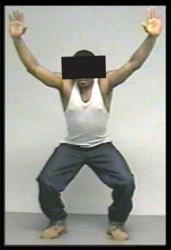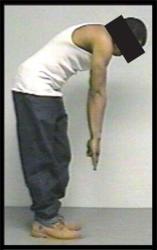How a High School Basketball Superstar Wrecked His Future Forever…And Why His Fate Could Be Yours Too—If You Don't Find and Fix Your Fatal Flaws
In YOUR Life, Do You Want to Be a BENCHWARMER — or a PLAYER, a DIFFERENCE-MAKER?
 |
This high school basketball star could only manage to squat and toe touch as shown—he declined to fix his imbalances and suffered career-ending injuries as a result in his senior year. |
 |
What are we all REAL GOOD at—and what do elite athletes EXCEL at? Compensating for a flaw, deficiency, or imbalance in the body. Option A is not available—our body jumps to Plan B. But plan B comes at a hidden price. In fact, the better you are at switching to Plan B the more surely you will be injured. Guaranteed, your durability will be a joke.
The athlete in the photos above is not faking. This is a high school junior several years ago who was leading his team, killing it on the court. He was a countywide superstar. Everybody was afraid of this kid on the court. But this is what he looked like off the court. That was his toe touch. That was his squat.
What do you think was going on with this kid? When he moved the way you know he must have moved on the court? Micro trauma every place. Guess what? He got injured his senior year. Missed his window. Didn't get a scholarship. Non-contact injury. Wouldn't do the work. Didn't fix it.
Yes, micro trauma. A series of minor stresses to the body resulting in limited area tissue damage or tears each of which alone does not cause discernable damage. However, their accumulation over time can lead to a significant injury. Inefficient movements cause compensations, which move a joint in an unnatural manner. The body will always sacrifice quality for quantity. Movement patterns will follow the path of least resistance.
When you stack these compensations on top of each other, screening for movement becomes essential.
How do we assess movement? Well, we break it down into these seven basic movement and stability programs. We squat. We step. We lunge. We reach. We leg raise. We push-up. And we look at rotary stability.
What the movement screen does is put people into categories and rank them. You can't actually fix anything until you rank it and identify it.
When we find out you can't toe touch and that also matches up with the fact that you can't deep squat and you also have a bad active straight leg raise, we can place you in a category that allows us to then evaluate what's going on and create a corrective strategy to address that.
Well, if the World Champion Indianapolis Colts insisted their players be screened before being cleared to play, we figured our Level 11 RKCs deserved training in this same cutting-edge process.
What you get here is every critical minute of the seminar Brett Jones delivered on this protocol to our Level II RKC candidates in June 2007. Brett's information was so impressive—and the results so spectacular that by popular demand, we are releasing the complete training on this 2-DVD set.
Contents include:
What is a Corrective Strategy?
Movement Screening — The Functional Movement Screen for Kettlebells
Basic history — injury, medical, exercise, sports/activity
Clearance screens — Neck, Shoulder and Back
Basic screens —Toe Touch, Single leg stance, Active Straight Leg Raise
Movement Screens — Deep squat, In-line Lunge, Shoulder Mobility and
Trunk Stability Push-up
Corrective Strategies — Specific to the screens above
Toe touch progression. Active straight leg raise. Crocodile breath
Shoulder/Thoracic spine corrections, Stability work and Deep squat progression